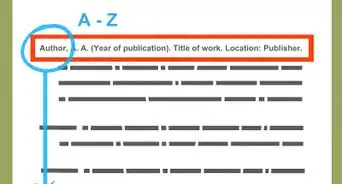This article was co-authored by Michelle Golden, PhD. Michelle Golden is an English teacher in Athens, Georgia. She received her MA in Language Arts Teacher Education in 2008 and received her PhD in English from Georgia State University in 2015.
wikiHow marks an article as reader-approved once it receives enough positive feedback. In this case, several readers have written to tell us that this article was helpful to them, earning it our reader-approved status.
This article has been viewed 324,846 times.
Shakespeare’s works follow a unique citation method that is specific to them. All citations are done parenthetically, which means that they appear within the text of your paper inside parentheses. There is certain information that must be included in citations of plays, including the act, scene and line numbers. Format them properly so that your reader knows exactly where your quoted material comes from.
Steps
Including Parenthetical Citations
-
1Use parenthetical citations for Shakespearean works. Parenthetical citations are citations that appear inside regular parentheses within the body of your paper. No matter which citation style you’re using, Shakespeare works are unique in how they are cited. They are always cited with parenthetical citations that appear in the text of your paper. They are not indicated by a footnote or endnote.[1]
-
2Include the citation at the end of the passage you’re quoting. When you quote a passage, wait until the very end of the section that you’re quoting before including your citation. Sometimes, the passage might be lengthy, such as a dialogue between two characters. The citation comes at the very end of this entire passage.[2]Advertisement
-
3Cite paraphrased material. If you’re not including the original passage in your paper and instead you’re paraphrasing a passage, you still need to indicate where this passage comes from. Include a citation formatted just the same as you’d use for a quotation.
- Don’t use quotation marks for paraphrased material.
-
4Go back to the original source. You may find a quote from a Shakespearean work in another piece of writing, such as a critique of the play you’re writing about. The quoted Shakespeare text might be exactly what you want to use. But in order to quote and cite it properly, you should go back to the original play or sonnet. This will help you read the quote in its proper context.
- Cite this quote as it appears in the original source, such as: Much Ado About Nothing (2.3.217–24).
Formatting Parenthetical Citations
-
1Include the play’s act, scene and line numbers in the citation. Plays are broken down into acts, scenes and lines. When citing Shakespeare, you’re giving the reader a roadmap of where to find the quoted material. [3]
- Separate each of these numbers with a period.
-
2Choose Arabic or Roman numerals to indicate the play’s act and scene. When giving the play’s act and scene number, you can write these in Arabic numbers (1, 2, 3, and so on) or Roman numerals (I, II, III, etc.).[4] Choose one format and be consistent with using it. The line numbers are always written with Arabic numbers.
- Most modern scholars prefer using Arabic numbers, but both formats are acceptable.[5]
- Write upper-case Roman numerals (I, II, III, etc.) for the play’s act number. Use lower-case Roman numerals for the scene number (i, ii, iii, etc.). For example, (IV.ii.56–57).
-
3Cite ranges of line numbers properly. Quoted material corresponds to certain lines within the work. When you have text that comes from more than one line, you need to include a range of line numbers.[6]
- If the range of line numbers is under 100, write: 66–84.
- If the range of line numbers is over 100, write: 122–34.
- If the range of line numbers extends from under 100 to over 100, write: 90–104.
- Put an en dash between the line numbers. This dash is slightly longer than a hyphen but not as long as a dash.
-
4Do not use page numbers. While most other citations require page numbers, Shakespeare works are an exception. Because the plays have been reproduced in so many different formats and publications, there is no consistency on page numbers. Therefore, never refer to page numbers when you are citing text from a Shakespeare play.[7]
-
5Include Shakespeare’s name if you’re comparing with another author. Generally, if your paper is only discussing Shakespeare’s works, you don’t need to write Shakespeare in the parenthetical citation. But if you are comparing with another author, you should differentiate each one by indicating the author in the parenthetical citation.
- In MLA format, write: (Shakespeare 3.4.40)
-
6Abbreviate the name of the play if necessary. You may need to differentiate frequently between two different plays in your parenthetical citations. Instead of writing the name out entirely every time, you can abbreviate the title. For example, you can write JC for Julius Caesar, Mac. For Macbeth, Rom. for Romeo and Juliet, etc. These would appear like this in your paper: (Mac. 1.3.15-20).,[8]
-
7Indicate the stage direction line number. If you are citing the stage directions that are given in a play, you need to tell the reader where you’re drawing them from. Indicate stage directions by giving the line number at the end of your citation.
- For example, the citation for a stage direction would read: 3.4.40.1. This means that the stage direction is at Line 1 after Line 40. [9]
-
8Place the punctuation properly. The amount of text you’re quoting will determine the placement of the punctuation at the end of a passage.[10]
- When citing fewer than four lines of verse, you will use quotation marks around the quoted material. Then write the parenthetical citation, and follow that with punctuation (a period, for example).
- When citing four or more lines, you will use a block quote. There are no quotation marks, and the ending punctuation (a period, for example) will go at the end of the last line. Then include the parenthetical citation.
Quoting Shakespeare in the Text
-
1Introduce the speaker. When quoting a passage, you need to indicate which character is talking (unless the verse is from a sonnet). You can introduce the speaker in your own writing, or you can include the character’s name in capital letters at the beginning of the verse. For example, choose one of these two options:[11]
- Othello recalls, "Upon this hint I spake: / She lov'd me for the dangers I had pass'd, / And I lov'd her that she did pity them" (I.iii.166–168). In this option, you need to include quotation marks where the spoken passage begins.
- ”OTHELLO: Upon this hint I spake: / She lov'd me for the dangers I had pass'd, / And I lov'd her that she did pity them” (I.iii.166–168). In this option, include quotation marks before you name the character, since this is how the name appears in the text.
-
2Use a forward slash (/) to separate fewer than four lines of verse. Citing verse in linear form means that the quotation from the text will not be in block form. This is reserved for passages that are fewer than four lines. If you have two or three lines of verse, separate these with a space, forward slash, space.[12]
- For example, write: “OTHELLO: Upon this hint I spake: / She lov'd me for the dangers I had pass'd, / And I lov'd her that she did pity them” (I.iii.166–168).[13]
- If you are quoting prose, then omit the slash and instead use a comma.
-
3Use block quotes for four or more lines of verse. Lengthier passages are set apart in the body of your paper in a block quote.[14] This appears as an indented set of lines when you have four or more lines of verse that you’re quoting.[15]
- Indent one inch from the left margin. The entire block quote will be set apart from the rest of your paper. Indent every line of the block quote one inch from the left-hand margin.
- Omit quotation marks. Block quotes are set apart from the rest of your text. Therefore, you do not need to set them apart by using quotation marks.[16]
- For example:
Hippolyta, I woo'd thee with my sword,
And won thy love, doing thee injuries;
But I will wed thee in another key,
With pomp, with triumph and with revelling. (1.1.19–22)
-
4Preserve the line breaks of the original verse in a block quote. Break each line at the same place as it is broken in the original.[17]
- If you are quoting prose, then you don’t need to preserve the line breaks. These will differ depending on the publication in which the work appears.
-
5Format dialogue between two characters correctly. When you want to quote dialogue between two or more characters, format it this segment as a block quote.
- Indent one inch on the first line and include the first character’s name in capital letters. Follow the name with a period. Then add a space and start the character’s dialogue. When you need to start a new line, indent an additional ¼ inch (putting this line one and ¼ inches from the left margin).
- Start a new line when another character speaks. Again, put this character’s name in capital letters and follow it with a period. Add a space and start the character’s dialogue.
- Include the parenthetical citation at the very end of the dialogue block.
- For example:
HAMLET. No, by the rood, not so:
You are the queen, your husband's brother's wife:
And--would it were not so!--you are my mother.
QUEEN. Nay, then, I'll set those to you that can speak. (3.4.14-17)
Including a Works Cited Page
-
1Include the publications or books that you used. You need to include a “works cited” page with your paper. This page lists the published material that you’ve used to write your paper. This might include a collection of Shakespeare’s works, a single volume with one play, or an anthology of several different authors’ works.[18]
- Depending on the citation style, the works cited page may be called a “bibliography” or a “references” page.
- Don’t just list the play that you’re citing. You need to indicate the publication in which the play appears.
- Alphabetize the works cited page.
- Sample entry for an anthology:
- Shakespeare, William. “The Comedy of Errors.” The Oxford Anthology of Tudor Drama. Ed. Greg Walker. Oxford, UK: Oxford U P, 2014. 682-722. Print.
- Sample entry for a collection of a single author’s works:
- Shakespeare, William. Love Poems and Sonnets of William Shakespeare. New York: Doubleday, 1991. Print.
- Sample entry for a single work:
- Shakespeare, William. Romeo and Juliet. Ed. Jill L. Levenson. New York: Oxford U P, 2000.
- Sample entry for a live play:
- Hamlet. By William Shakespeare. Dir. Dominic Dromgoole and Bill Buckhurs. Shakespeare's Globe, London. 25 April 2014. Performance.
-
2
-
3Include the works cited page as the final page of your paper. The works cited page starts on a new page after your essay. Title this page “Works Cited” with the words centered and bolded at the top of the page.
- Align each entry on the left.
Community Q&A
-
QuestionIf I'm changing or adding something do I use ( ) or [ ]?
 LouisaCommunity AnswerYou should use brackets [ ] within the quote if you are adding clarification or showing gaps in the quote.
LouisaCommunity AnswerYou should use brackets [ ] within the quote if you are adding clarification or showing gaps in the quote. -
QuestionDo I use double space in block quoting?
 DonaganTop AnswererYes. A space before and after a block quote makes it easier to recognize as a quote.
DonaganTop AnswererYes. A space before and after a block quote makes it easier to recognize as a quote. -
QuestionHow do I cite a line from a play that I'm using for an epigraph in a poem that I've written?
 DonaganTop AnswererWrite the line below your title but above your text, and follow it with a comma or dash and the playwright's name. You could also italicize the line and/or the name.
DonaganTop AnswererWrite the line below your title but above your text, and follow it with a comma or dash and the playwright's name. You could also italicize the line and/or the name.
References
- ↑ https://bu.digication.com/wr100h2/Citation_Resources
- ↑ https://bu.digication.com/wr100h2/Citation_Resources
- ↑ http://drmarkwomack.com/mla-style/how-to-quote/quote-shakespeare/
- ↑ https://bu.digication.com/wr100h2/Citation_Resources
- ↑ http://drmarkwomack.com/mla-style/how-to-quote/quote-shakespeare/
- ↑ http://drmarkwomack.com/mla-style/how-to-quote/quote-shakespeare/
- ↑ http://drmarkwomack.com/mla-style/how-to-quote/quote-shakespeare/
- ↑ https://bu.digication.com/wr100h2/Citation_Resources
- ↑ https://bu.digication.com/wr100h2/Citation_Resources
- ↑ https://bu.digication.com/wr100h2/Citation_Resources
- ↑ http://public.wsu.edu/~delahoyd/shakespeare/mla.html
- ↑ https://bu.digication.com/wr100h2/Citation_Resources
- ↑ http://public.wsu.edu/~delahoyd/shakespeare/mla.html
- ↑ http://drmarkwomack.com/mla-style/how-to-quote/quote-shakespeare/
- ↑ https://bu.digication.com/wr100h2/Citation_Resources
- ↑ http://drmarkwomack.com/mla-style/how-to-quote/quote-shakespeare/
- ↑ https://bu.digication.com/wr100h2/Citation_Resources
- ↑ http://lib.pstcc.edu/c.php?g=106731&p=693753
- ↑ http://public.wsu.edu/~delahoyd/shakespeare/mla.html
About This Article
To cite Shakespeare, use parenthetical citations that include the act, scene, and line numbers at the end of the related passages. Be sure to cite both direct quotes and paraphrased sections! Remember to pull direct quotes from Shakespeare's original works rather than books about his works. When quoting a passage, always indicate which character is speaking by introducing them in your own writing, or including their name in capital letters at the beginning of the verse. To learn more from our English Ph.D. co-author, like how to include Shakespeare in a Works Cited page, keep reading the article!





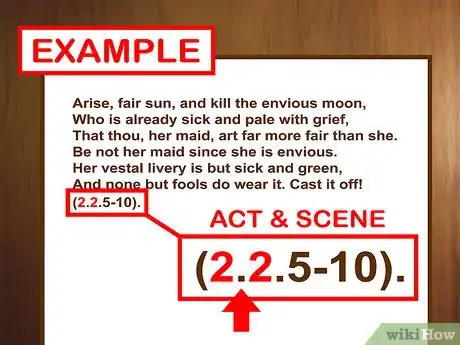
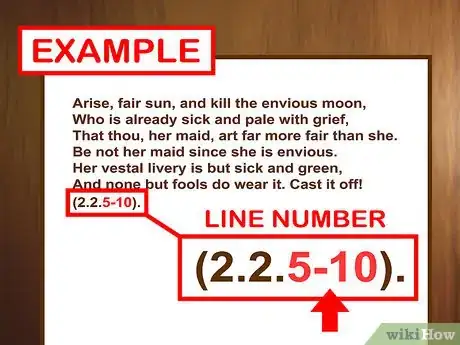
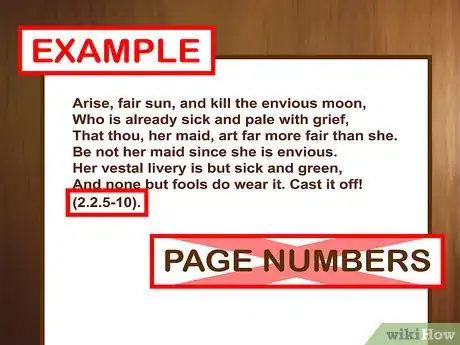
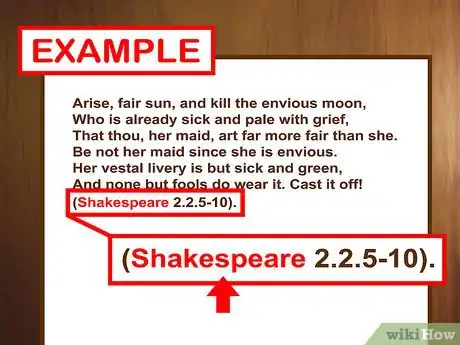
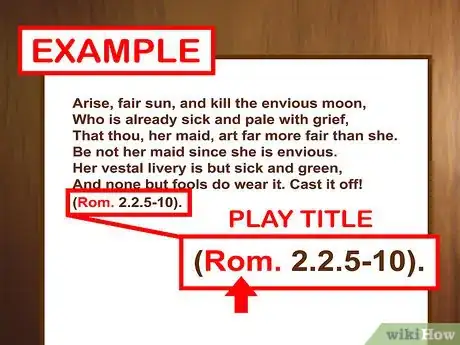
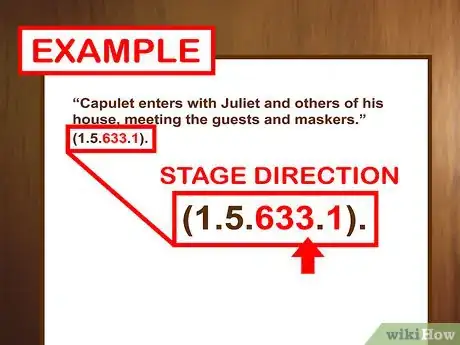
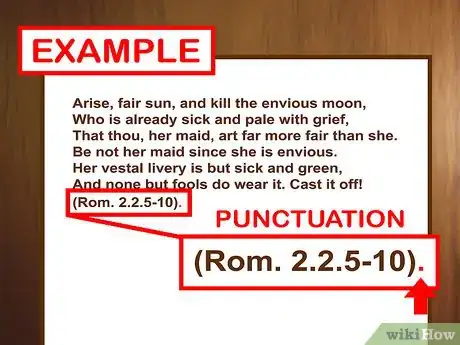


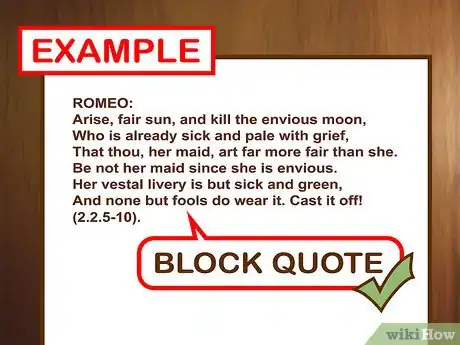

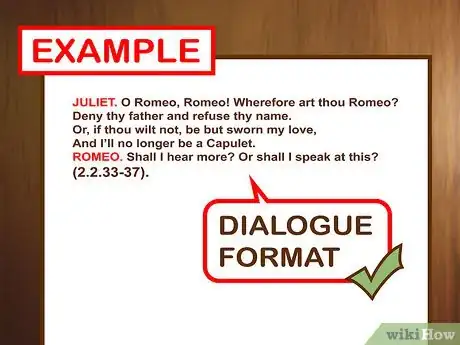

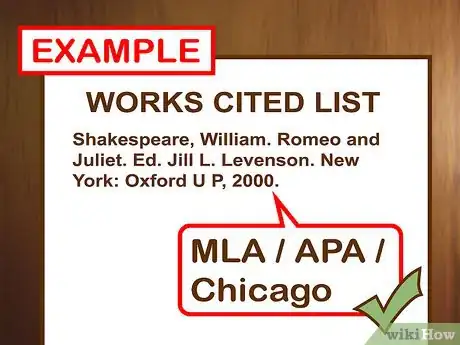











-Step-18.webp)

